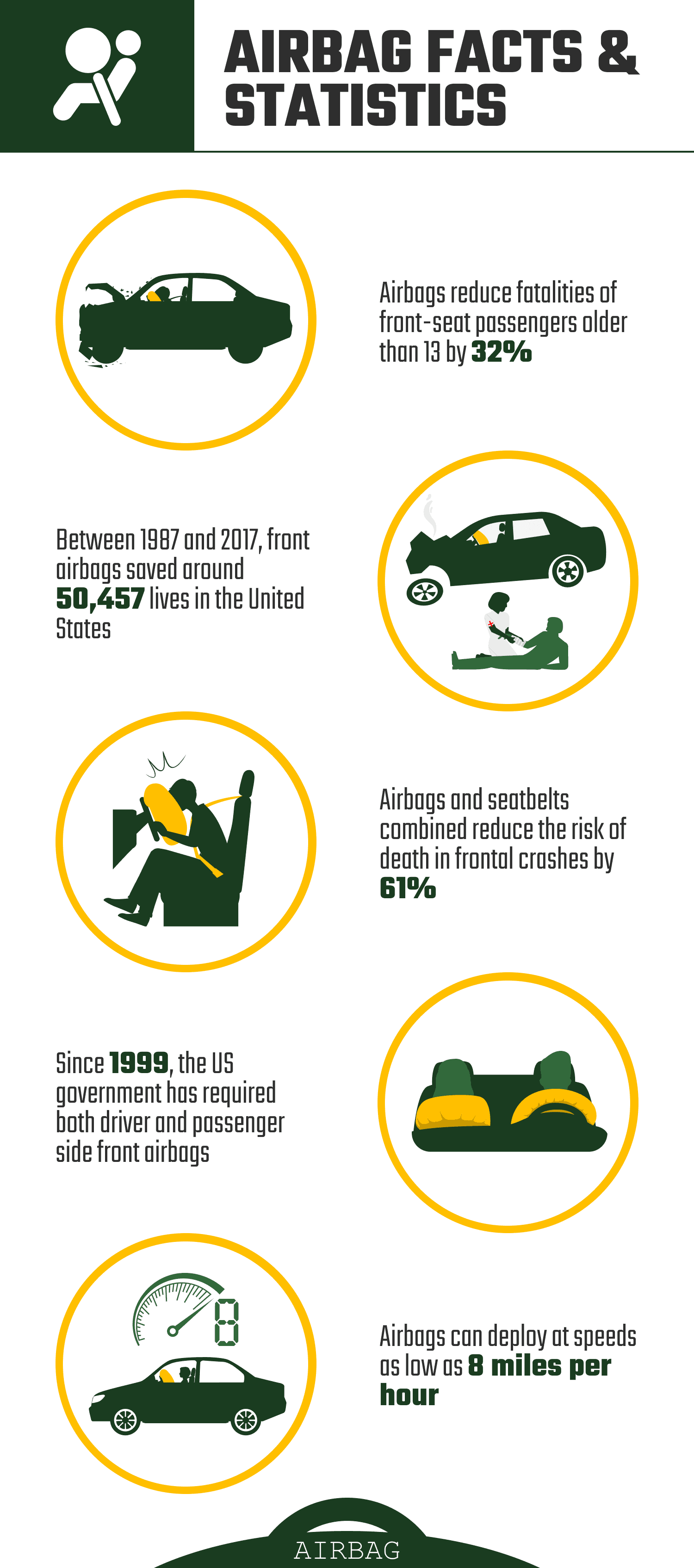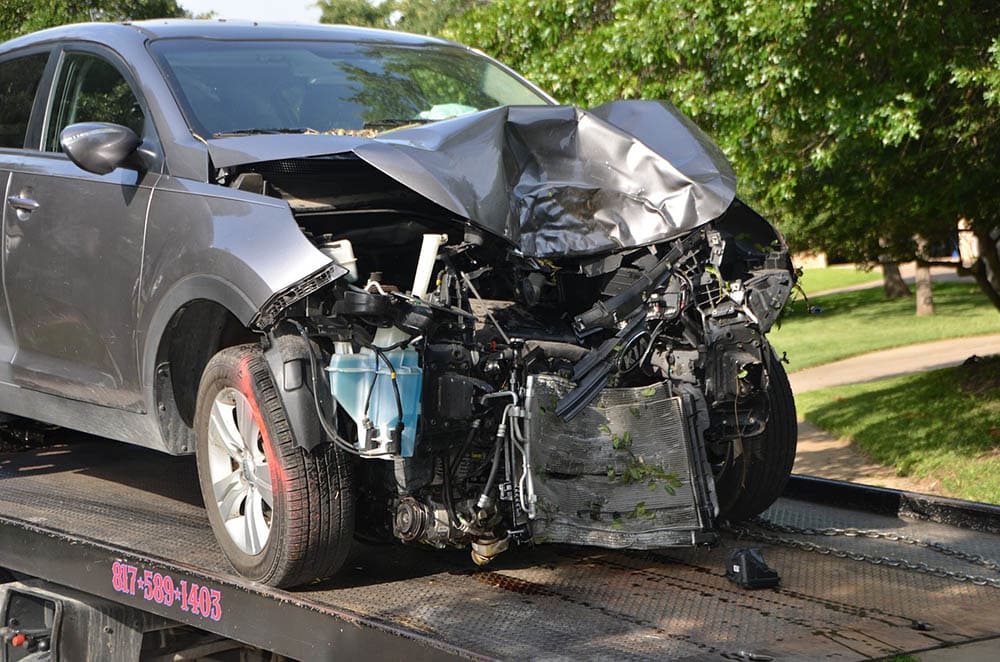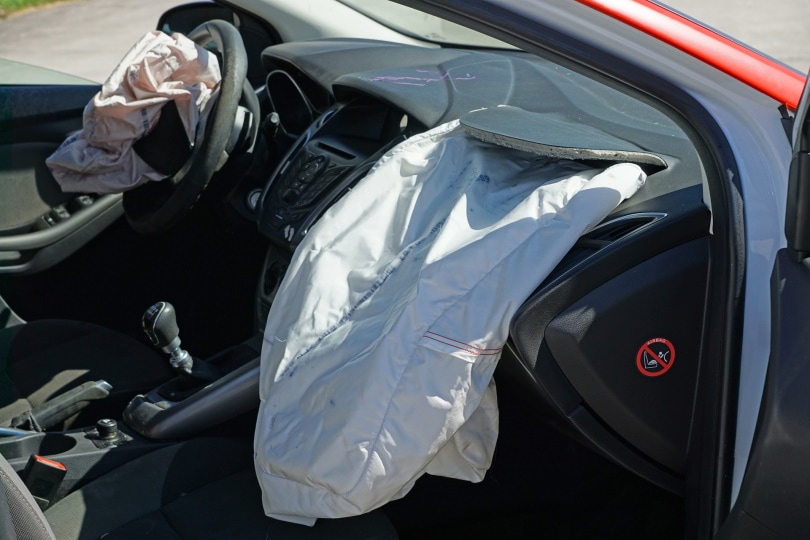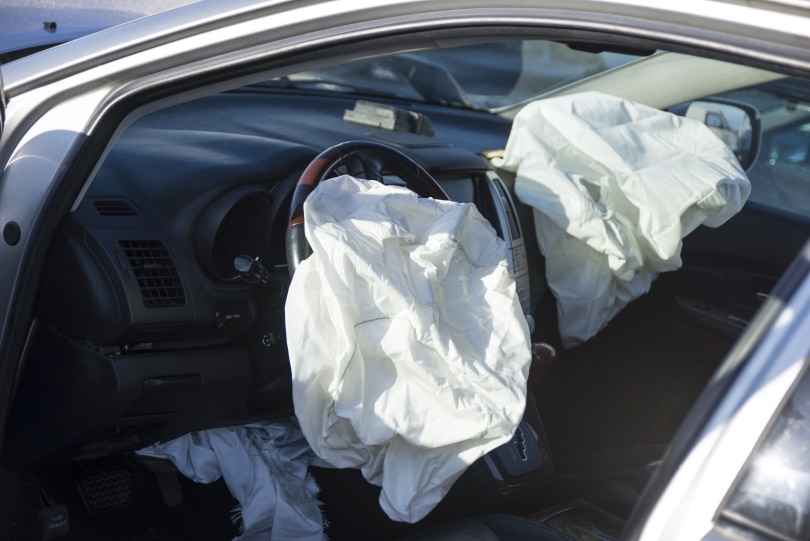15 Eye-Opening Airbag Statistics and Facts: 2025 Update
-
Pete Ortiz
- Last updated:

Note: This article’s statistics come from third-party sources and do not represent the opinions of this website.
Besides the seatbelt, finding a safety device inside a vehicle that has saved more lives is hard. But just how many lives have airbags saved, and how effective are they? We have everything you need to know here and we’ve answered the most frequently asked questions about airbags. When you’re ready to satisfy your curiosity, go ahead and dive right in!
Click below to jump ahead:
Top 15 Airbag Statistics
- Airbags reduce fatalities of front-seat passengers older than 13 by 32%.
- Side airbags can reduce an SUV driver’s risk of death by 52%.
- From 1987 to 2017, front airbags have saved 50,457 lives in the United States.
- In 2017, airbags saved 2,790 lives.
- The NHTSA recalled 70 million Takata airbags because of a serious safety issue.
- Airbags killed 116 children from 1996 to 2000.
- Airbags killed 75 adults from 1996 to 2000.
- Airbags and seatbelts combined reduce the risk of death in frontal crashes by 61%.
- Since 1999, the U.S. government has required both driver and passenger side front airbags.
- 163 million U.S. vehicles have driver-side airbags.
- Adding airbags to all cars in Argentina, Chile, Mexico, and Brazil could save 40,000 lives in 14 years.
- From 2014 on, every U.S. vehicle has side airbags.
- Each airbag costs an auto manufacturer $50.
- Side airbags deploy within 10 to 20 milliseconds of a crash.
- Airbags can deploy at speeds as low as 8 miles per hour.

Lives Saved From Airbags
1. Airbags reduce fatalities of front-seat passengers older than 13 by 32%.
(Insurance Institute for Highway Safety)
No matter where you’re in the vehicle and what else you’re doing, the statistics are clear; if you’re an adult, you’re far safer with an airbag than without one. When you look at the massive number of auto accidents each year, 32% is incredibly impressive.

2. Side airbags can reduce an SUV driver’s risk of death by 52%.
(National Highway Traffic Safety Administration)
If you’re driving an SUV, airbags do even more good for you than a traditional vehicle. In fact, if your SUV has side airbags, they can reduce your chance of death in a side collision by 52%!
3. From 1987 to 2017, front airbags have saved 50,457 lives in the United States.
(Insurance Institute for Highway Safety)
When you transfer those percentages to lives saved, it’s even more impressive. From 1987 to 2017, seatbelts have saved over 50,000 lives alone! When you break that down, seatbelts save almost 1,700 lives a year just in the United States!

4. In 2017, airbags saved 2,790 lives.
(National Highway Traffic Safety Administration)
Globally, few safety devices are as effective in saving lives as airbags. Due to advances in airbags and higher usage numbers, they saved close to 2,800 lives in 2017 alone!
Concerning Airbag Statistics
5. The NHTSA recalled 70 million Takata airbags because of a serious safety issue.
(Insurance Institute for Highway Safety)
While this is a concerning statistic, it’s important to note that the faulty airbags only led to 15 deaths. Compared to the tens of thousands of lives airbags have saved, the evidence is still clear that you want them in your vehicle.

6. Airbags killed 116 children from 1996 to 2000.
(New York Times)
While airbags are great for adults, they don’t protect kids very well. From 1996 to 2000, airbags killed 116 children. Because of these alarming statistics, you should never put children in the front seat of vehicles.
7. Airbags killed 75 adults from 1996 to 2000.
(New York Times)
While airbags save thousands of lives each year, they are responsible for some deaths. From 1996 to 2000, they killed roughly 75 adults. Still, compared to the thousands of lives they save each year, we’re far better off with airbags than without them.

8. Airbags and seatbelts combined reduce the risk of death in frontal crashes by 61%.
(National Highway Traffic Safety Administration)
While airbags are a great safety invention, when you pair them with seatbelts, they only get more effective. If you’re wearing both your seatbelt and have an airbag in your vehicle, it reduces the likelihood of death by 61%!
Airbag Usage Statistics
9. Since 1999, the U.S. government has required both driver and passenger side front airbags.
(Insurance Institute for Highway Safety)
If you get into a newer vehicle in the United States, it has an airbag. If you get in any newer vehicle from a major automobile manufacturer in a developed country, it should have an airbag. These excellent safety features are standard, which saves a ton of lives.

10. 163 million U.S. vehicles have driver-side airbags.
(Insurance Institute for Highway Safety)
With all modern vehicles having at least driver-side airbags, it’s no surprise that the number of vehicles with airbags in them is high. However, 163 million in the U.S. alone is still a staggering number to look at!
11. Adding airbags to all cars in Argentina, Chile, Mexico, and Brazil could save 40,000 lives in 14 years.
(NPR)
While airbags are mandatory in the United States, that’s not the case everywhere. Argentina, Chile, Mexico, and Brazil don’t represent the largest markets, but they could save about 2,800 lives a year by mandating airbags in their vehicles.

12. From 2014 on, every U.S. vehicle has side airbags.
(Insurance Institute for Highway Safety)
While having side airbags isn’t a requirement for new vehicles in the United States, there are still incredibly high safety standards that vehicle manufacturers need to meet to sell vehicles there. The easiest way to meet the side impact standards is to install side airbags, which is why it’s the route that most manufacturers take.
Other Airbag Facts
13. Each airbag costs an auto manufacturer $50.
(NPR)
While airbags used to be expensive additions to cars and are still expensive for you to replace, the truth is that it doesn’t cost much for a vehicle manufacturer to put them in a vehicle. At $50 an airbag, they’re not driving up the cost of your vehicle much.

14. Side airbags deploy within 10 to 20 milliseconds of a crash.
(Insurance Institute for Highway Safety)
In order for your airbag to effectively protect you, they need to be able to deploy fast. Side airbags are extremely effective at this and can deploy in the blink of an eye after a collision. Considering that humans can see things in 13 milliseconds, some side airbags are so fast you can’t tell they’re deploying after a collision!
15. Airbags can deploy at speeds as low as 8 miles per hour.
(Insurance Institute for Highway Safety)
There’s a misconception that airbags only go off at high speeds. The truth is that low-speed accidents can also be fatal, which is why some airbags will go off after just 8-mile-per-hour collisions. However, modern airbags are effective at only going off when they absolutely need to, so don’t think that they’ll deploy for just any fender bender.

Frequently Asked Questions About Airbags
The more facts you learn, the more questions you probably have! We understand, and that’s why we answered the most frequently asked questions.
How Fast Do Air Bags Deploy?
Airbags deploy quickly, and while they can detect a crash and deploy in just .05 seconds, the speed of the airbag is a bit frightening too. An airbag can deploy at about 200 miles per hour, which can easily cause an injury in its own right. (Clemson University Vehicular Electronics Laboratory)

What Kind of Gas Is Inside an Airbag?
The main gas inside an airbag is argon or nitrogen, depending on the airbag manufacturer. Both are non-toxic gases that react extremely well with sodium azide, which is why they’re so prominent in airbags. (McGill Office for Science and Society)
How Long Until an Airbag Deflates?
While airbags can deploy in milliseconds, they generally stay inflated longer. Typically, an airbag deflates relatively slowly, but by the 2-second mark, it generally reaches the same atmospheric pressure as its surroundings and loses effectiveness. (Department of Chemistry Washington University)
What Kind of Chemical Is in Airbags?
Sodium azide is the primary chemical inside airbags to help them deploy. It reacts and creates an explosion when the airbag needs to deploy to get everything started. The white powder in most airbags is talcum powder. (Centers for Disease Control)

Will Airbags Work Without Seatbelts?
Airbags should still deploy regardless of whether you’re wearing your seatbelt. Newer airbags use seatbelt sensors that will cause the airbag to deploy sooner if you’re not wearing your seatbelt. Still, airbags are far more effective when wearing a seatbelt, so it’s always best to keep it on, even if your vehicle has airbags. (Insurance Institute for Highway Safety)
Conclusion
Automobile accidents cause numerous injuries and deaths every year, but airbags and seatbelts have made driving safer. The data is clear; airbags save lives. So, if you’re wondering whether those small and often-forgotten devices in your vehicle are worth it, the answer is yes. Even better, they don’t add much to the cost of your car, meaning that it’s one device that doesn’t really have a downside.
Stick with the airbags and save lives!
- Insurance Institute for Highway Safety
- National Highway Traffic Safety Administration
- New York Times
- National Highway Traffic Safety Administration
- NPR
- Clemson University Vehicular Electronics Laboratory
- McGill Office for Science and Society
- Department of Chemistry Washington University
- Centers for Disease Control
Featured Image Credit: Sony Ho, Shutterstock
Contents


